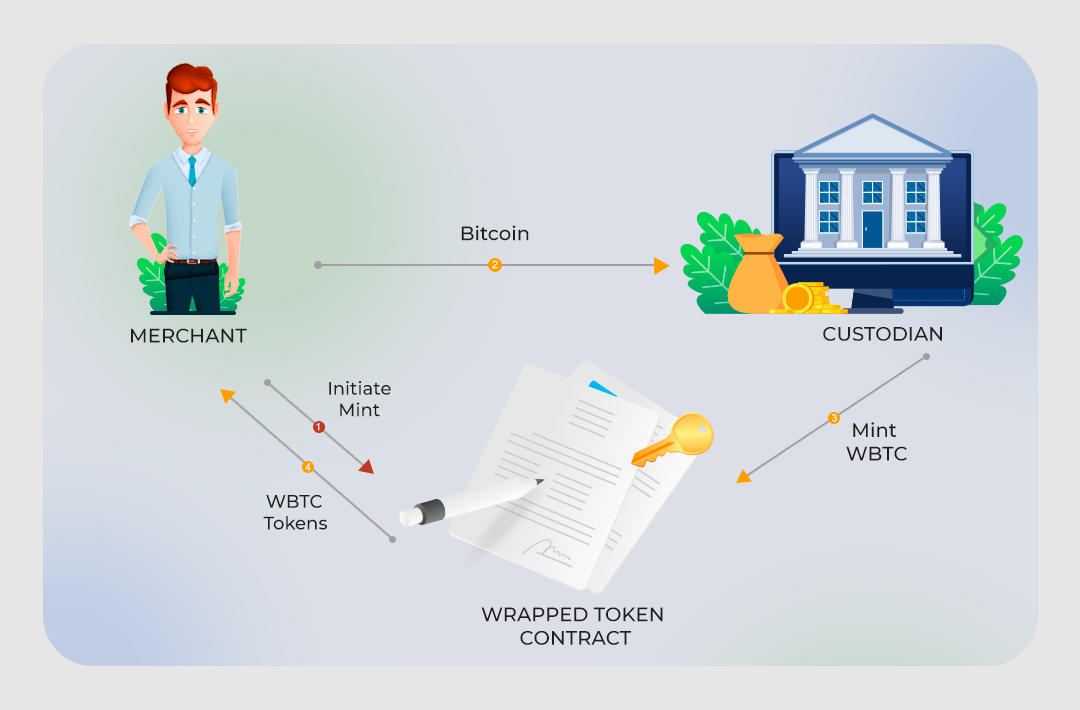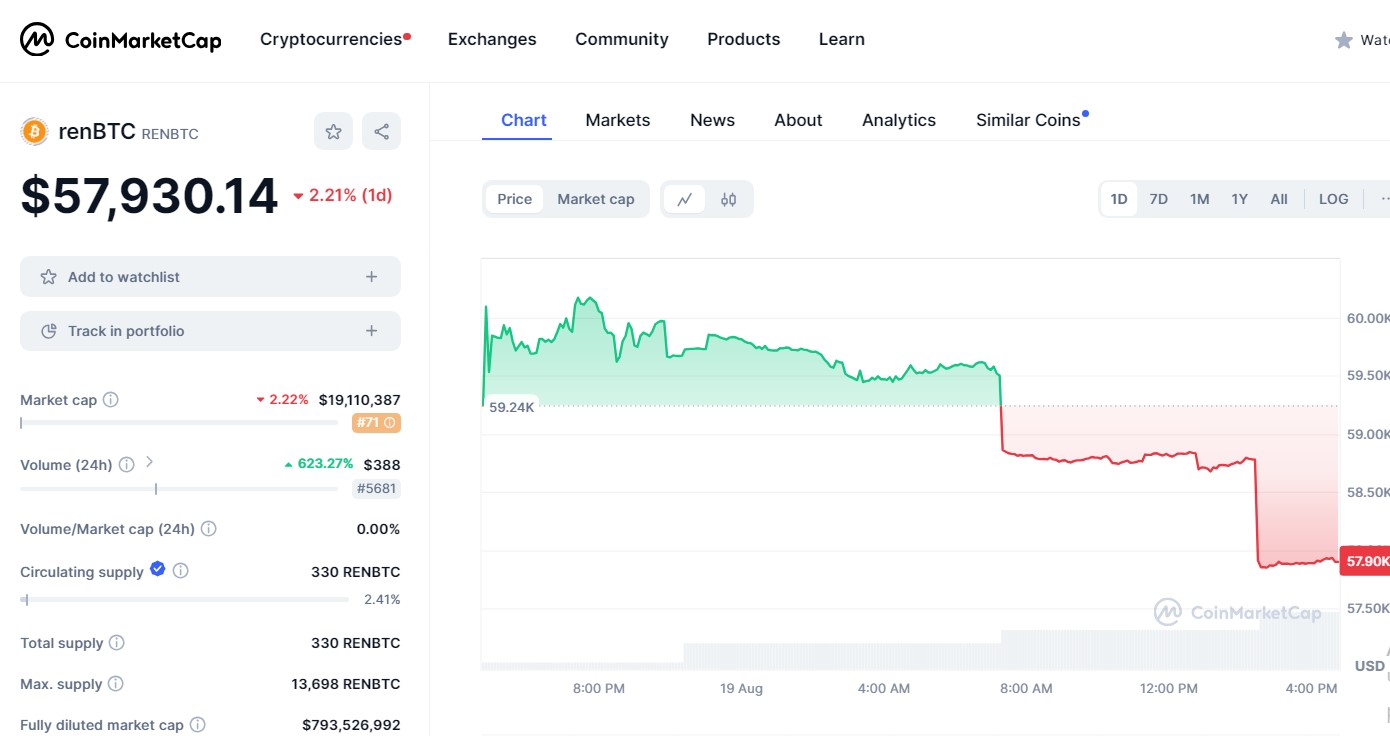What is a wrapped bitcoin?
We talked about the way to use the largest cryptocurrency in the decentralized finance sector

03.07.2024
236
8 min
0
In the more than a decade since the first cryptocurrency was launched, many coins have appeared on the market, but bitcoin still remains the most recognizable digital asset. Because the bitcoin protocol does not initially support shared smart contracts, there is no easy way to use it in the decentralized finance (DeFi) sector. Wrapped Bitcoin (WBTC) has emerged as a solution to this problem. In this article, we will take a closer look at what WBTC is and what it is for.
Content:
- What are wrapped cryptocurrencies?
- Features of Wrapped Bitcoin
- Ecosystem and how it works
- How to buy Wrapped Bitcoin?
- Pros and cons of Wrapped Bitcoin
- What can be done with WBTC?
- Alternatives to WBTC
- Conclusion
What are wrapped cryptocurrencies?
Before moving on to WBTC, it is worth explaining what wrapped (or tokenized) cryptocurrencies are. These are digital assets that represent some coin on other blockchains. The purpose of these tokens is to be usable in the broader blockchain ecosystem and enable cross-chain interoperability.
The wrapping process involves locking the original digital asset on its native blockchain in smart contracts. Once a certain amount of coins is blocked, a similar amount is minted in the form of a wrapped cryptocurrency on another blockchain.
Features of Wrapped Bitcoin
WBTC is an ERC-20 standard token on the Ethereum blockchain, pegged to the value of bitcoin 1:1. It was launched in January 2019 as a way to give decentralized applications (DApps) on Ethereum access to WBTC. Multi-chain platform Kyber Network, cryptocurrency custodian BitGo, and private investment platform Republic Protocol were involved in the development of the project.
WBTC listed popular DeFi platforms such as Compound, Dharma, and dYdX immediately after its launch. Prior to WBTC, the only way to use BTC in financial transactions was through centralized organizations such as centralized exchanges (CEX).
| Token name and ticker | Wrapped Bitcoin (WBTC) |
| Developer website | https://wbtc.network |
| Link to CoinMarketCap | https://coinmarketcap.com/currencies/wrapped-bitco... |
| Link to explorer | https://www.blockchain.com/ru/explorer/assets/wbtc |
| Link to X | https://twitter.com/WrappedBTC |
| Standard | ERC-20 |
The main goal of WBTC is to provide crypto traders with an easy way to use their BTC assets in Ethereum-based DeFi protocols. Ethereum supports smart contracts, unlike the bitcoin blockchain, allowing developers to create DApps.
Traders use WBTC to access decentralized trading, lending, and borrowing (lending protocols). For example, if BTC holders want to generate passive income from their long-term bitcoin investments, they can issue WBTC and lend it in protocols on Ethereum.
One particular advantage WBTC has over bitcoin is speed. Transactions with wrapped bitcoins are done through the Ethereum blockchain, where blocks are generated every 15 seconds. In comparison, blocks are created on average every 10 minutes on the bitcoin blockchain.
Ecosystem and how it works
The Wrapped Bitcoin lifecycle process involves several participants, each performing unique tasks:
- Custodian. They are responsible for preserving the original bitcoin, creating new WBTC tokens, and destroying unsecured assets. The custodian is BitGo, which also ensures that transparency conditions are met.
- Merchant. Organizations for which the issuance and burning of wrapped bitcoins is done. They also distribute the tokens. The first companies to take on this task are Kyber Network and Republic Protocol.
- Customers. These are investors who intend to use their ВТС in decentralized applications.

The wrapping process begins when a bitcoin holder requests WBTC from a seller in exchange for BTC. Upon receiving the request, the seller performs KYC identification of the BTC holder and establishes a transaction with the custodian, who is authorized to issue a new WBTC. The seller receives the tokens and sends the BTC to the custodian. At the last stage, the seller, and the bitcoin owner exchange BTC for WBTC, either through CEX or by performing an atomic swap.
How to buy Wrapped Bitcoin?
If you do not have the time or desire to deal with bitcoin wrapping, you can buy it on a crypto platform. Let’s understand how to do this with the example of the Bybit exchange.
- First, you need to register and confirm a new account or log in to an existing one. You can create an account using this link.
- Through the navigation menu, you should go to the cryptocurrency purchase page.
- Next, you need to enter the amount of USDT stablecoins to buy, select the currency for payment, and one of the proposed payment services.
- If you have not previously passed verification, the platform will request it at the next stage.
- After successfully completing the KYC procedure, the purchased stablecoins can be used to purchase WBTC on Bybit spot/derivatives.
The received tokens can be stored in any crypto wallet that supports Ethereum and allows interaction with DeFi projects:
MetaMask. A browser extension and mobile app for Android and iOS are available.
Trust Wallet. A popular wallet, developed by the Binance exchange, provides staking and connectivity to dApps in 50+ different blockchains.
Guarda Wallet. A cross-platform solution is available in browsers, PC, and phones, while it is possible to set up login via hardware storage to increase security.
You should remember to follow security rules and use only trusted and reliable resources to buy and store cryptocurrencies.
Pros and cons of Wrapped Bitcoin
| Pros | Cons |
|
The ability to apply a tokenized version of the first cryptocurrency on a blockchain that is not its original network. |
The coin creation process can be expensive due to the transaction fees associated with it |
|
Reduced transaction times and lower transaction fees if a higher performingblockchain is used. |
The funds are under the control of a custodian, which should ensure that reserves can be monitored. That said, concentrating a significant amount of assets in one person leads to a degree of centralization. |
|
A simple and fast process of creating wrapped coins that is accessible even for beginners. |
|
| Increased capital efficiency and liquidity. |
What can be done with WBTC?
WBTC is one of the largest and fastest growing digital assets. Once converted, wrapped bitcoins can be used in numerous DApps. The DeFi market provides different opportunities for WBTC holders:
- Using BTC as collateral to obtain crypto loans on DeFi platforms thanks to smart contracts.
- Transferring WBTC into decentralized credit pools. WBTC brings liquidity to credit pools and holders can earn interest on their investments.
- Margin trading with WBTC on DeFi derivatives trading platforms. These exchanges are non-custodial and operate through smart contracts that keep funds safe during trading.
- Staking. Investors who hold BTC and are looking for ways to generate passive income in the cryptocurrency market can engage in staking with WBTC on the Ethereum blockchain.
Alternatives to WBTC
Wrapped Bitcoin is not the only option for moving bitcoin to the Ethereum network. One of the alternatives is renBTC, which is a wrapped bitcoin based on the Ren protocol. Many experts see renBTC as one of the main rivals to WBTC. Ren technology greatly simplifies the process of transferring assets from different blockchains to Ethereum.

Another alternative to WBTC is tBTC from cryptographic services provider Threshold Network. The asset is also based on the ERC-20 standard and is supported by Curve DAO, Yearn.Finance, Synthetix, Connext, Alchemix, Euler, and AaveChan protocols.

Conclusion
Wrapped bitcoin is an advanced technology that has bridged the gap between the two largest networks, Bitcoin and Ethereum. It has allowed BTC holders to take advantage of the DeFi sector and its rapidly growing number of applications. Moreover, WBTC provides greater liquidity on CEXs and DEXs and improves investment efficiency.
Useful material?
Articles
How the largest cryptocurrency exchange’s initiatives help it maintain its leadership
Nov 19, 2022
Articles
What fan coins are needed for and what events contribute to their growth
Nov 16, 2022
Articles
Why Binance set the trend to publish transparent data on available funds
Nov 14, 2022
Articles
The journalists got acquainted with the documents revealing the details of the financial condition of the exchange
Nov 13, 2022
Articles
Desperate traders with stuck assets resort to semi-legal schemes to save deposits
Nov 11, 2022
Articles
Experts predict when to expect new peaks of the crypto market by analyzing its previous cycles
Nov 10, 2022









 Telegram
Telegram  Twitter
Twitter